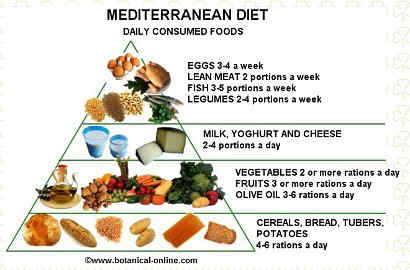Contents
- 1 MEDITERRANEAN DIET TO AVOID DIABETES
- 1.1 NUTRITIONAL PYRAMID FOR DIABETES
- 1.2 The basis of the diet should be the vegetables.
- 1.3 How many vegetables a day?
- 1.4 Whole fruit, not juice
- 1.5 Olive oil for dressing and cooking
- 1.6 Increase consumption of legumes.
- 1.7 Choose whole grains.
- 1.8 Tubers and pasta from time to time in moderate rations
- 1.9 Fish as the main source of animal protein.
MEDITERRANEAN DIET TO AVOID DIABETES
The Mediterranean diet is one of the most balanced and comprehensive in the world. It is characterized by the use of olive oil, fish and especially abundant in vegetables and fruits present in every dish.
To enjoy the benefits of the Mediterranean diet, people with diabetes need to make some changes to the food pyramid:
NUTRITIONAL PYRAMID FOR DIABETES

Food pyramid of Mediterranean diet for people with diabetes. Unlike conventional pyramid, in this case vegetables and olive oil are the mainstay of the diet.
The basis of the diet should be the vegetables.
Vegetables such as carrots, zucchini, tomatoes or squash provide us slowly absorbed carbohydrates that should be accounted for in the diet.
Instead, more fibrous vegetables such as cabbage, spinach, cauliflower or spinach, provide fiber that helps lower cholesterol and improve levels of blood glucose.
Peppers are a good source of vitamin C (more important than oranges), we can add them to our salads, since they have few carbohydrates
How many vegetables a day?
You should take 3 to 4 servings of vegetables a day. For example, a salad, a vegetable dish and a vegetable omelet.
Whole fruit, not juice
Fruit is an important source of vitamin C and soluble fiber. It may be lacking in the diet for diabetes, but bear in mind its contribution into simple sugars.
Avoid juices as they lose the benefits of fiber and have a higher glycemic index.
You should take about 2-3 whole fruits a day. Avoid juices.
Olive oil for dressing and cooking

Olive oil is always present in a Mediterranean diet for diabetes
Olive oil is the basis of any healthy diet, and it presents many benefits in diabetes diet. You can also take fruit also rich in omega 9, such as hazelnuts, almonds and avocados.
Animal fat should be replaced by olive oil. This change reduces the risk of metabolic disease and improves the health of the heart and vascular system. Choose low-fat dairy and low fat cheeses.
Milk must not be forgotten in this diet, as in a balanced eating plan, it is an important source of calcium.
Take 30 to 60ml. of extra virgin olive oil a day. Equivalent to 3-6 tablespoons oil.
Increase consumption of legumes.
Legumes are a source of vegetable protein and carbohydrates with low glycemic index. They are well suited in diabetes because they provide fiber and important minerals for bones as magnesium and calcium.
Choose whole grains.

Whole cereals should not be excluded in the Mediterranean diet for diabetes
Cereals should be consumed in rations established by patient and insulin doses. However, they must not be totally excluded from the diet since they must be present in some amount.
You must choose whole cereals, since they are absorbed more slowly and at long term they improve glycosylated hemoglobin levels: brown rice, whole wheat, rye, millet, quinoa, buckwheat, etc.
They must be taken 3 to 4 times a week. Take whole cereals in moderate portions.
Tubers and pasta from time to time in moderate rations
Tubers, such as potatoes and pasta, are not recommended too often and should be taken in moderate portions.
Fish as the main source of animal protein.
Fish is rich in Omega 3 essential fatty acids, important for preventing heart disease. They also provide iodine, a mineral essential for the functioning of the thyroid gland. Their protein content is equal to the animal flesh.
*Related information: Foods in the Mediterranean diet.
![]() More information on Benefits of the Mediterranean diet.
More information on Benefits of the Mediterranean diet.








